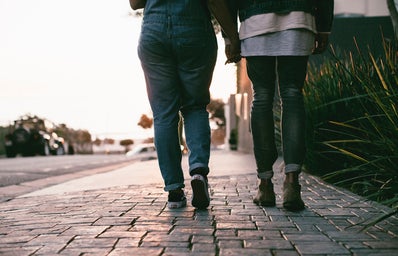Contributed By: McKinleigh Nelsen, Kyli Patterson, Kayla Swiderski, and Maya McGuire
Margaret Mead, a world renowned cultural anthropologist, once said, “Any town that does not have sidewalks does not love its children.” Mead’s quote embodies what we, a group of passionate SLU students, want people to understand about sidewalks and their importance with our St. Louis based initiative, “Walk it Out.” Sidewalks are an underappreciated lifeline to communities and cities that should be highlighted and used to their full potential.
As college students, especially at Saint Louis University (SLU), our entire livelihoods are based upon our accessibility to sidewalks. We use sidewalks everyday for a variety of activities like traveling to classes or on-campus events, socializing with friends, and exercising. Outside of SLU or other college campuses, how often do you personally use sidewalks? Do you use the sidewalks in your hometown to walk places, talk to friends, or exercise? Most people have alternative ways to get around, spaces to hang out with friends, and places to exercise. Outside of college campuses, sidewalks are under-utilized and underappreciated in the United States. In this article, we hope to inform you about the uses of sidewalks and how they benefit one’s mental and physical health.
In Europe, sidewalks were originally adopted by urban planners, allowing citizens to socialize and safely promenade throughout the city. These sidewalks were lined with special embellishments such as greenery and benches, which encouraged and invited the public to avidly use them. Sidewalks were also seen as a public health amenity and contributed to the “cleansing” of the city. Since then, sidewalks have become a staple in city planning, but in the United States, they have become attached to the image of the college campus.
Despite the original purpose to unite communities, sidewalks are now seemingly ignored by the public. Individuals can not only use sidewalks as a mode of transportation, but also as an area to exercise, or express creativity. Walk it Out feels that sidewalks are the most beneficial when used for exercise. Exercising with the use of sidewalks can take place in many forms such as walking, biking or running.
Exercising, in general, is a great way to improve one’s overall health, but more specifically, physical health. The Mayo Clinic recommends 30 minutes of exercise every day, which adds up to at least 150 minutes per week. Sidewalks give individuals of any status or stature a better opportunity to achieve these health standards. This daily exercise can help reduce your risk of a heart attack, manage your weight better, lower blood cholesterol levels, decrease the risk of developing Type 2 Diabetes, lower the risk of acquiring certain cancers, lower blood pressure, strengthen your bones and joints and lower your risk of developing osteoporosis.
Sidewalks provide a gateway for exercise that not only promotes physical health, but also mental health. As college students, we are all under a constant amount of pressure and stress. This constant stress can have negative effects on people’s mental health, and can even lead to burnout. Burnout occurs when someone is under prolonged stress that causes mental, emotional and physical exhaustion. Therefore, we all need to find ways to relieve the stress that we are experiencing. The National Center for Biotechnology Information (NCBI) states that exercise helps improve mental health by improving sleep, reducing stress, improving one’s mood, increasing energy and stamina, and reducing tiredness. The NCBI also conducted a meta-analysis that stated exercise is effective for both preventing and reversing burnout.
On top of dealing with the stress from college and daily life, we are all experiencing an additional level of stress due to the COVID-19 pandemic. The Centers for Disease Control and Prevention explain that exercise can help cope with the stress caused by the pandemic. Going for a daily walk is an effective way to get in the recommended amount of daily exercise, but also provides an escape from the house. The entire world has been isolated at home for days on end and going for a walk, bike ride or run is a safe way to offset the effects of isolation. COVID-19 has become an incredulous stressor for people, and exercising outside, using sidewalks, is a great way to relieve that stress.
Sidewalks provide a gateway for people to exercise, but also provide other benefits such as spending time in nature. When someone uses sidewalks to exercise outside, they become immersed in the natural environment. A study done at Harvard University explains that spending 20 to 30 minutes a day in nature can drastically reduce stress. Without sidewalks, many people would not have a safe and free way to get outside to exercise. Walking, running, or biking directly on the street is dangerous, and walking directly on the grass beside the street is not accessible for those who use a wheelchair, want to push a stroller or have difficulty walking on uneven surfaces. Sidewalks become the gateway to the outdoors by providing a safe, free and widely accessible avenue for exercise.
Spending time in nature and exercising are great ways to reduce stress and improve one’s physical and mental well-being. Sidewalks make these activities possible wherever you are. Some fun ways to get outside and get active in St. Louis include taking a trip to the City Garden, the Missouri Botanical Garden, the St. Louis Zoo, Castlewood State Park, Forest Park or the Katy Trail State Park.
Remember that exercising helps your physical and mental health, and sidewalks give you the opportunity to simply “Walk It Out!”
To learn more about our team, follow us on Instagram @walkitoutstl.


